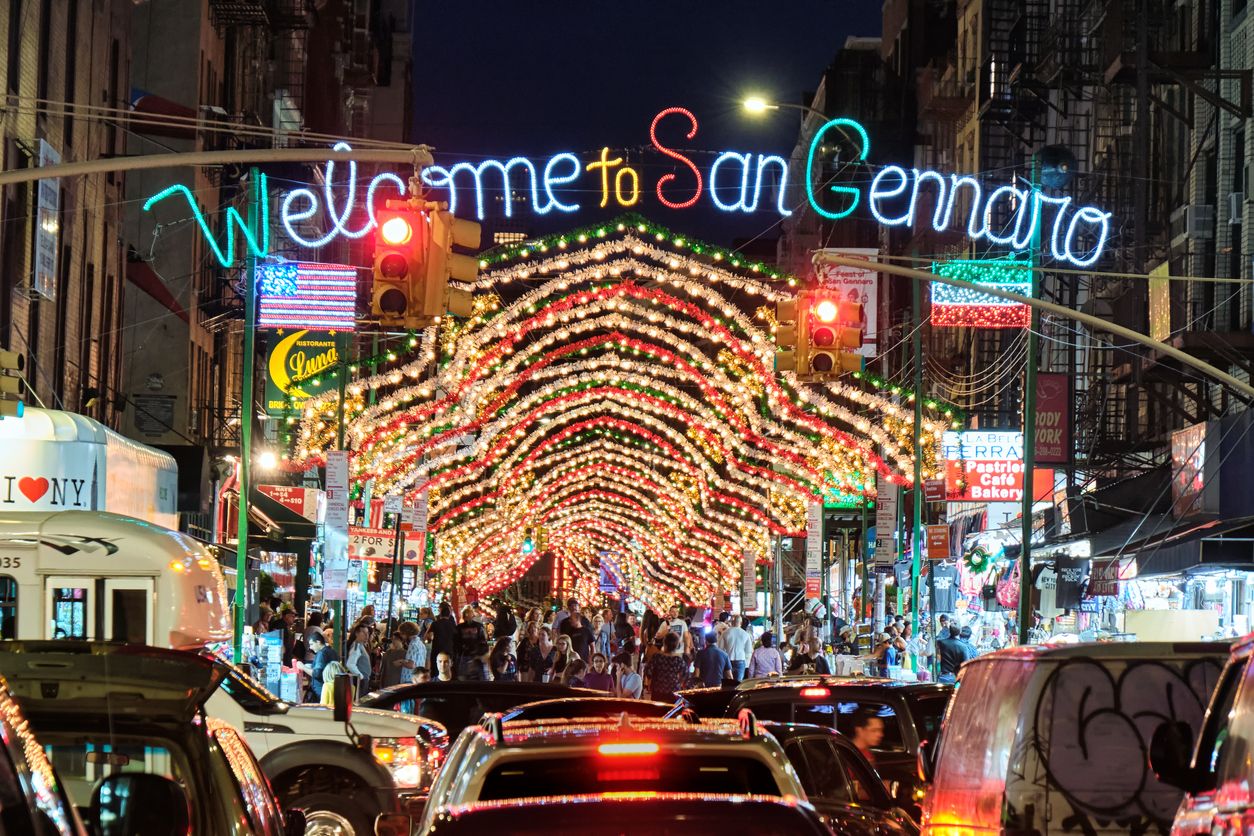
Ever wondered what makes the San Gennaro Feast so special? This annual celebration in Little Italy, New York City, honors Saint Januarius, the patron saint of Naples. Originating in 1926, this vibrant event spans 11 days, from September 12 to 22, drawing over a million visitors each year. The feast is a sensory delight, featuring mouth-watering Italian dishes like sausage and peppers, zeppole, and cannoli. Beyond the food, the festival includes lively parades, religious ceremonies, carnival games, and amusement rides. It’s a cultural extravaganza that brings together people from all walks of life to celebrate Italian-American heritage.
Key Takeaways:
- The San Gennaro Feast originated in Naples, Italy, and honors Saint Januarius, known for his martyrdom and the miraculous liquefaction of his blood. It has become a vibrant celebration in New York City, showcasing Italian culture, food, and traditions.
- The San Gennaro Feast in New York City features delicious Italian cuisine, lively parades, entertainment, and family-friendly activities. It holds significant historical and cultural value, attracting over a million visitors each year and representing the enduring legacy of Italian-American culture.
The Origins of San Gennaro Feast
The San Gennaro Feast is a vibrant celebration with deep roots in Italian culture. Let's explore its origins and key elements.
-
Origin: The Feast of San Gennaro began in Naples, Italy, where Saint Januarius is honored as the city's main patron.
-
Patron Saint: Saint Januarius, known for his martyrdom in 305 AD, is the central figure of this feast.
-
Martyrdom: Legend says Saint Januarius was tortured and beheaded during Emperor Diocletian's persecution.
-
Blood Miracle: His blood, which normally solidifies, is believed to liquefy twice a year on May 1 and September 19, considered a miracle.
The First Celebration in New York City
The San Gennaro Feast made its way to New York City thanks to Italian immigrants. Here's how it all began.
-
First Celebration: The first New York City celebration took place in 1926, initiated by Italian immigrants from Naples.
-
Location: Held in Little Italy, Manhattan, an area once home to a large Italian-American community.
-
Duration: The feast typically lasts 11 days, from September 12 to September 22.
-
Hours of Operation: Runs from 11 AM to 11 PM on weekdays and until midnight on weekends.
Food and Culinary Delights
Food is a major highlight of the San Gennaro Feast. Let's dive into the delicious offerings.
-
Food: Italian cuisine takes center stage with dishes like sausage and peppers, zeppole, cannoli, and braciole.
-
Sausage and Peppers: Grilled Italian sausage with sautéed peppers and onions, often served in a sandwich roll.
-
Zeppole: Deep-fried dough balls dusted with powdered sugar, a festival staple.
-
Cannoli: Crisp pastry tubes filled with sweet ricotta cheese, sometimes garnished with chocolate chips or candied fruit.
-
Braciole: Thin slices of beef rolled with garlic, parsley, and cheese, then simmered in tomato sauce.
Parades, Entertainment, and Religious Ceremonies
The feast isn't just about food. It also features parades, entertainment, and religious ceremonies.
-
Parades and Entertainment: Lively parades, live music, and traditional Italian performances are part of the festivities.
-
Grand Procession: On September 14, from 2 PM to 5 PM, participants in traditional attire carry the statue of Saint Januarius through Little Italy.
-
Religious Ceremonies: Daily masses and devotional services at the Shrine Church of the Most Precious Blood honor the feast's spiritual origins.
Games, Rides, and Family Fun
The San Gennaro Feast offers fun activities for all ages, making it a family-friendly event.
-
Games and Rides: Carnival games and rides add to the festive atmosphere, providing entertainment for families and children.
-
Carnival Games: Various games line the festival, offering chances to win prizes.
-
Amusement Rides: Thrilling rides set up on Grand Street cater to visitors of all ages.
Historical and Cultural Significance
The feast holds significant historical and cultural value, representing the legacy of Italian immigrants.
-
Historical Significance: The feast represents the traditions of early Italian immigrants who settled in Little Italy.
-
Attendance: Attracts over a million people each year, making it one of New York City's most popular events.
-
Neighborhood Impact: For generations, this feast has been a vital part of the neighborhood, symbolizing the culture and traditions of the Italian-American community.
Bi-Annual Festivals and International Celebrations
The San Gennaro Feast isn't limited to New York City. It has expanded to other locations as well.
-
Bi-Annual Festivals: Bi-annual festivals are held in Las Vegas/Henderson, NV, and Tampa & Hallandale Beach, FL, celebrating Italian heritage.
-
International Food Vendors: These festivals feature a wide range of ethnic food vendors, offering diverse culinary experiences.
-
Arts and Crafts: Include home exhibits, face painters, and live international acts from Italy and the Las Vegas Strip on the main concert stage.
Live Performances and Amusement Rides
Entertainment is a key part of the feast, with live performances and thrilling rides.
-
Live Performances: The main concert stage features traditional Italian music and contemporary acts.
-
Amusement Rides and Games: Known for the biggest and most thrilling amusement rides and games in the valley.
-
Parent Wristbands: Free parent wristbands with the purchase of a child’s unlimited ride wristband make it a family-friendly event.
Community and Cultural Exchange
The San Gennaro Feast fosters community engagement and cultural exchange.
-
Community Engagement: Engages the community through activities like religious ceremonies, parades, and live performances.
-
Historical Preservation: Helps preserve the history and traditions of Italian immigrants in Little Italy.
-
Tourist Attraction: A significant tourist attraction, drawing visitors from around the world.
-
Food Contests: Includes cannoli, zeppole, and meatball eating contests, adding to the festive spirit.
-
Cultural Exchange: Offers visitors a chance to experience Italian-American cuisine, music, and traditions firsthand.
-
Family-Friendly: Designed to be family-friendly, with activities for all ages.
Support and Legacy
The feast's success is supported by the community and local businesses, ensuring its continued growth.
-
Community Support: Receives support from local businesses and organizations.
-
Iconic Event: Symbolizes New York City’s rich cultural diversity and historical heritage.
-
Legacy: Continues to be a testament to the enduring legacy of Italian-American culture in New York City.
-
Grand Marshall: For the 2024 event, Chef Anne Burrell, known for hosting Food Network’s "Worst Cooks in America," will be the Grand Marshall.
-
Neighborhood Impact: Represents not only Saint Januarius but also the ancestors, culture, and traditions of the Italian-American community.
-
Cultural Significance: More than just a celebration, it’s a cultural event that brings together people from diverse backgrounds to experience Italian-American traditions.
Celebrating Tradition and Community
The San Gennaro Feast in Little Italy, NYC, is more than just a festival. It’s a vibrant celebration of Italian-American culture and tradition. Originating in 1926, this 11-day event honors Saint Januarius, the patron saint of Naples. With delicious Italian food like sausage and peppers, zeppole, and cannoli, the feast attracts over a million visitors each year. The grand procession, lively parades, and religious ceremonies add depth to the festivities. Carnival games and rides make it a family-friendly event. The feast also takes place bi-annually in Las Vegas, Henderson, NV, Tampa, and Hallandale Beach, FL, showcasing Italian heritage. This iconic event preserves the legacy of Italian immigrants, fostering community and cultural exchange. The San Gennaro Feast remains a testament to the enduring spirit of Italian-American traditions, drawing people from all walks of life to celebrate together.
Frequently Asked Questions
Was this page helpful?
Our commitment to delivering trustworthy and engaging content is at the heart of what we do. Each fact on our site is contributed by real users like you, bringing a wealth of diverse insights and information. To ensure the highest standards of accuracy and reliability, our dedicated editors meticulously review each submission. This process guarantees that the facts we share are not only fascinating but also credible. Trust in our commitment to quality and authenticity as you explore and learn with us.


